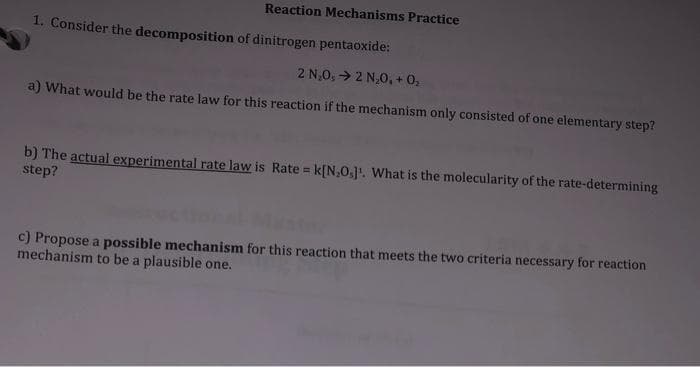inisms Practice 1. Consider the decomposition of dinitrogen pentaoxide: 2 N,0, > 2 N,0, +0, a) What would be the rate law for this reaction if the mechanism only consisted of one elementary step? b) The actual experimental rate law is Rate = k[N,O,]'. What is the molecularity of the rate-determining step? c) Propose a possible mechanism for this reaction that meets the two criteria necessary for reaction mechanism to be a plausible one.
inisms Practice 1. Consider the decomposition of dinitrogen pentaoxide: 2 N,0, > 2 N,0, +0, a) What would be the rate law for this reaction if the mechanism only consisted of one elementary step? b) The actual experimental rate law is Rate = k[N,O,]'. What is the molecularity of the rate-determining step? c) Propose a possible mechanism for this reaction that meets the two criteria necessary for reaction mechanism to be a plausible one.
Chemistry & Chemical Reactivity
10th Edition
ISBN:9781337399074
Author:John C. Kotz, Paul M. Treichel, John Townsend, David Treichel
Publisher:John C. Kotz, Paul M. Treichel, John Townsend, David Treichel
Chapter14: Chemical Kinetics: The Rates Of Chemical Reactions
Section14.7: Reaction Mechanisms
Problem 14.14CYU: One possible mechanism for the decomposition of nitryl chloride, NO2CI, is What is the overall...
Related questions
Question

Transcribed Image Text:Reaction Mechanisms Practice
1. Consider the decomposition of dinitrogen pentaoxide:
2 N,0, > 2 N,0,+ 0,
a) What would be the rate law for this reaction if the mechanism only consisted of one elementary step?
b) The actual experimental rate law is Rate = k[N,OJ. What is the molecularity of the rate-determining
step?
c) Propose a possible mechanism for this reaction that meets the two criteria necessary for reaction
mechanism to be a plausible one.
Expert Solution
This question has been solved!
Explore an expertly crafted, step-by-step solution for a thorough understanding of key concepts.
Step by step
Solved in 3 steps

Knowledge Booster
Learn more about
Need a deep-dive on the concept behind this application? Look no further. Learn more about this topic, chemistry and related others by exploring similar questions and additional content below.Recommended textbooks for you

Chemistry & Chemical Reactivity
Chemistry
ISBN:
9781337399074
Author:
John C. Kotz, Paul M. Treichel, John Townsend, David Treichel
Publisher:
Cengage Learning

Chemistry: An Atoms First Approach
Chemistry
ISBN:
9781305079243
Author:
Steven S. Zumdahl, Susan A. Zumdahl
Publisher:
Cengage Learning

Chemistry
Chemistry
ISBN:
9781305957404
Author:
Steven S. Zumdahl, Susan A. Zumdahl, Donald J. DeCoste
Publisher:
Cengage Learning

Chemistry & Chemical Reactivity
Chemistry
ISBN:
9781337399074
Author:
John C. Kotz, Paul M. Treichel, John Townsend, David Treichel
Publisher:
Cengage Learning

Chemistry: An Atoms First Approach
Chemistry
ISBN:
9781305079243
Author:
Steven S. Zumdahl, Susan A. Zumdahl
Publisher:
Cengage Learning

Chemistry
Chemistry
ISBN:
9781305957404
Author:
Steven S. Zumdahl, Susan A. Zumdahl, Donald J. DeCoste
Publisher:
Cengage Learning


Chemistry: The Molecular Science
Chemistry
ISBN:
9781285199047
Author:
John W. Moore, Conrad L. Stanitski
Publisher:
Cengage Learning

Chemistry: Principles and Practice
Chemistry
ISBN:
9780534420123
Author:
Daniel L. Reger, Scott R. Goode, David W. Ball, Edward Mercer
Publisher:
Cengage Learning